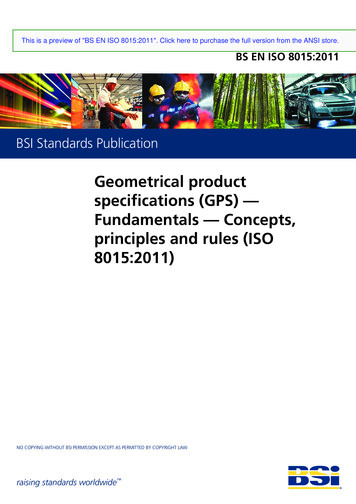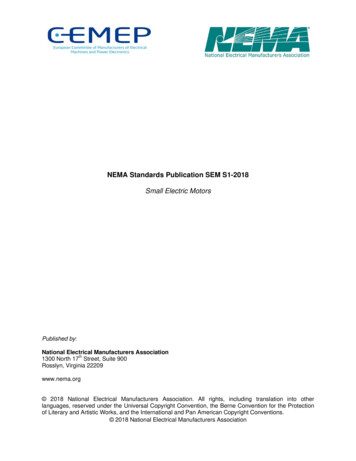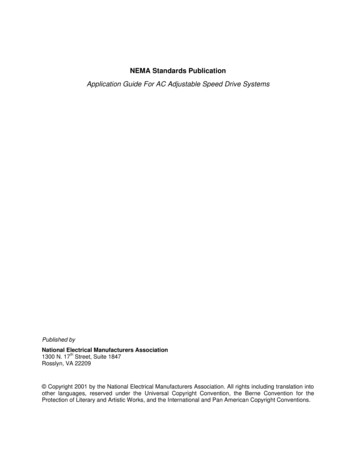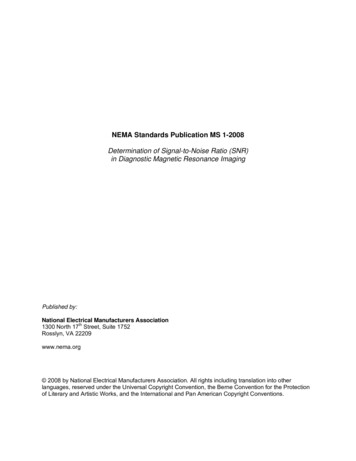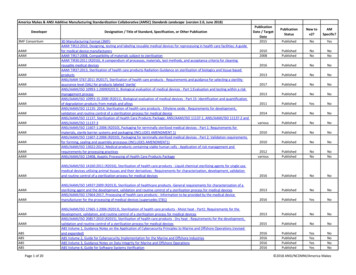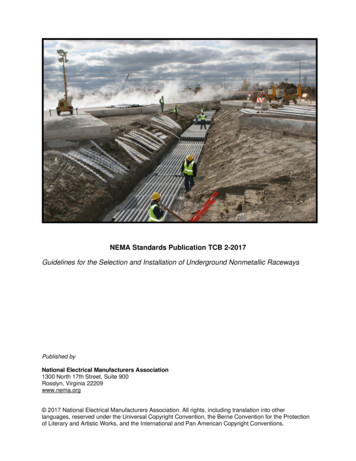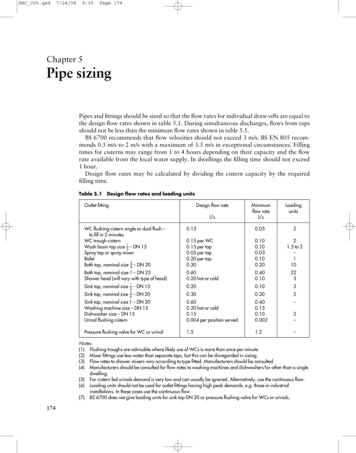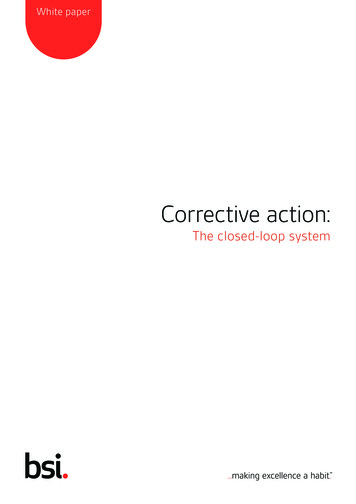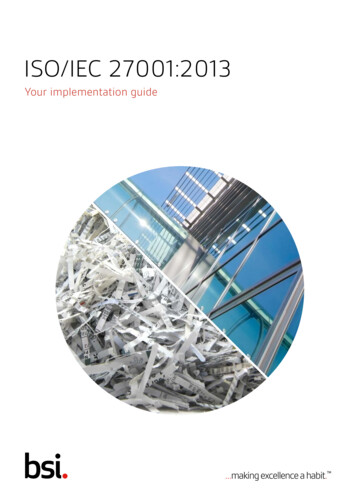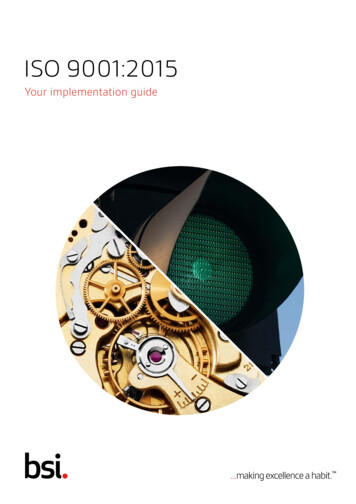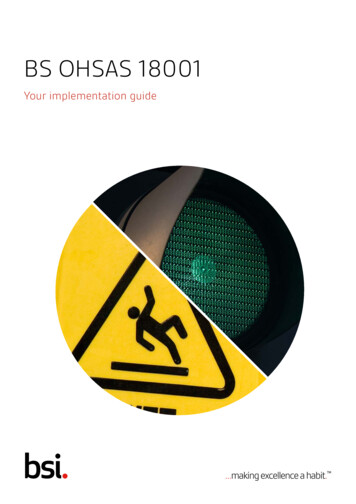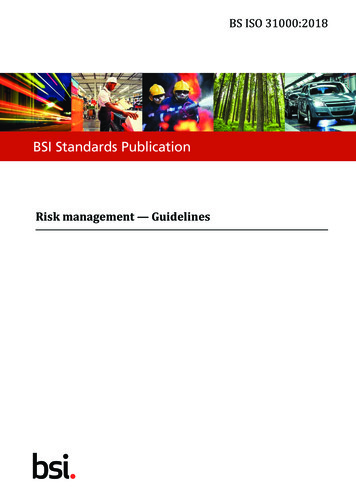
Transcription
BS ISO 31000:2018BSI Standards PublicationRisk management — Guidelines
BS ISO 31000:2018BRITISH STANDARDNational forewordThis British Standard is the UK implementation of ISO 31000:2018. Itsupersedes BS ISO 31000:2009, which is withdrawn.The UK participation in its preparation was entrusted to TechnicalCommittee RM/1, Risk management.A list of organizations represented on this committee can be obtained onrequest to its secretary.This publication does not purport to include all the necessary provisionsof a contract. Users are responsible for its correct application. The British Standards Institution 2018Published by BSI Standards Limited 2018ISBN 978 0 580 88518 1ICS 03.100.01Compliance with a British Standard cannot confer immunity fromlegal obligations.This British Standard was published under the authority of theStandards Policy and Strategy Committee on 28 February 2018.Amendments/corrigenda issued since publicationDateText affected
INTERNATIONALSTANDARDBS ISO 31000:2018ISO31000Second edition2018-02-15Risk management — GuidelinesManagement du risque — Lignes directricesReference numberISO 31000:2018(E) ISO 2018
BS ISO 31000:2018ISO 31000:2018(E) COPYRIGHT PROTECTED DOCUMENT ISO 2018, Published in SwitzerlandAll rights reserved. Unless otherwise specified, no part of this publication may be reproduced or utilized otherwise in any formor by any means, electronic or mechanical, including photocopying, or posting on the internet or an intranet, without priorwritten permission. Permission can be requested from either ISO at the address below or ISO’s member body in the country ofthe requester.ISO copyright officeCh. de Blandonnet 8 CP 401CH-1214 Vernier, Geneva, SwitzerlandTel. 41 22 749 01 11Fax 41 22 749 09 47copyright@iso.orgwww.iso.orgii ISO 2018 – All rights reserved
BS ISO 31000:2018ISO 31000:2018(E) Contents PageForeword. ivIntroduction.v123456Scope. 1Normative references. 1Terms and definitions. 1Principles. 2Framework. 45.1General. 45.2Leadership and commitment. 55.3Integration. 55.4Design. 65.4.1Understanding the organization and its context. 65.4.2Articulating risk management commitment. 65.4.3Assigning organizational roles, authorities, responsibilities andaccountabilities. 75.4.4Allocating resources. 75.4.5Establishing communication and consultation. 75.5Implementation. 75.6Evaluation. 85.7Improvement. 85.7.1Adapting. 85.7.2Continually improving. 8Process. 86.1General. 86.2Communication and consultation. 96.3Scope, context and criteria. 106.3.1General. 106.3.2Defining the scope. 106.3.3External and internal context. 106.3.4Defining risk criteria. 106.4Risk assessment. 116.4.1General. 116.4.2Risk identification. 116.4.3Risk analysis. 126.4.4Risk evaluation. 126.5Risk treatment. 136.5.1General. 136.5.2Selection of risk treatment options. 136.5.3Preparing and implementing risk treatment plans. 146.6Monitoring and review. 146.7Recording and reporting. 14Bibliography. 16 ISO 2018 – All rights reserved iii
BS ISO 31000:2018ISO 31000:2018(E) ForewordISO (the International Organization for Standardization) is a worldwide federation of national standardsbodies (ISO member bodies). The work of preparing International Standards is normally carried outthrough ISO technical committees. Each member body interested in a subject for which a technicalcommittee has been established has the right to be represented on that committee. Internationalorganizations, governmental and non-governmental, in liaison with ISO, also take part in the work.ISO collaborates closely with the International Electrotechnical Commission (IEC) on all matters ofelectrotechnical standardization.The procedures used to develop this document and those intended for its further maintenance aredescribed in the ISO/IEC Directives, Part 1. In particular the different approval criteria needed for thedifferent types of ISO documents should be noted. This document was drafted in accordance with theeditorial rules of the ISO/IEC Directives, Part 2 (see www.iso.org/directives).Attention is drawn to the possibility that some of the elements of this document may be the subject ofpatent rights. ISO shall not be held responsible for identifying any or all such patent rights. Details ofany patent rights identified during the development of the document will be in the Introduction and/oron the ISO list of patent declarations received (see www.iso.org/patents).Any trade name used in this document is information given for the convenience of users and does notconstitute an endorsement.For an explanation on the voluntary nature of standards, the meaning of ISO specific terms andexpressions related to conformity assessment, as well as information about ISO’s adherence to theWorld Trade Organization (WTO) principles in the Technical Barriers to Trade (TBT) see the followingURL: www.iso.org/iso/foreword.html.This document was prepared by Technical Committee ISO/TC 262, Risk management.This second edition cancels and replaces the first edition (ISO 31000:2009) which has beentechnically revised.The main changes compared to the previous edition are as follows:— review of the principles of risk management, which are the key criteria for its success;— highlighting of the leadership by top management and the integration of risk management, startingwith the governance of the organization;— greater emphasis on the iterative nature of risk management, noting that new experiences,knowledge and analysis can lead to a revision of process elements, actions and controls at eachstage of the process;— streamlining of the content with greater focus on sustaining an open systems model to fit multipleneeds and contexts.iv ISO 2018 – All rights reserved
BS ISO 31000:2018ISO 31000:2018(E) IntroductionThis document is for use by people who create and protect value in organizations by managing risks,making decisions, setting and achieving objectives and improving performance.Organizations of all types and sizes face external and internal factors and influences that make ituncertain whether they will achieve their objectives.Managing risk is iterative and assists organizations in setting strategy, achieving objectives and makinginformed decisions.Managing risk is part of governance and leadership, and is fundamental to how the organization ismanaged at all levels. It contributes to the improvement of management systems.Managing risk is part of all activities associated with an organization and includes interaction withstakeholders.Managing risk considers the external and internal context of the organization, including humanbehaviour and cultural factors.Managing risk is based on the principles, framework and process outlined in this document, asillustrated in Figure 1. These components might already exist in full or in part within the organization,however, they might need to be adapted or improved so that managing risk is efficient, effectiveand consistent.dFigure 1 — Principles, framework and process ISO 2018 – All rights reserved v
This page deliberately left blank
BS ISO 31000:2018INTERNATIONAL STANDARD ISO 31000:2018(E)Risk management — Guidelines1 ScopeThis document provides guidelines on managing risk faced by organizations. The application of theseguidelines can be customized to any organization and its context.This document provides a common approach to managing any type of risk and is not industry orsector specific.This document can be used throughout the life of the organization and can be applied to any activity,including decision-making at all levels.2 Normative referencesThere are no normative references in this document.3 Terms and definitionsFor the purposes of this document, the following terms and definitions apply.ISO and IEC maintain terminological databases for use in standardization at the following addresses:— ISO Online browsing platform: available at http://www.iso.org/obp— IEC Electropedia: available at http://www.electropedia.org3.1riskeffect of uncertainty on objectivesNote 1 to entry: An effect is a deviation from the expected. It can be positive, negative or both, and can address,create or result in opportunities and threats.Note 2 to entry: Objectives can have different aspects and categories, and can be applied at different levels.Note 3 to entry: Risk is usually expressed in terms of risk sources (3.4), potential events (3.5), their consequences(3.6) and their likelihood (3.7).3.2risk managementcoordinated activities to direct and control an organization with regard to risk (3.1)3.3stakeholderperson or organization that can affect, be affected by, or perceive themselves to be affected by adecision or activityNote 1 to entry: The term “interested party” can be used as an alternative to “stakeholder”.3.4risk sourceelement which alone or in combination has the potential to give rise to risk (3.1) ISO 2018 – All rights reserved 1
BS ISO 31000:2018ISO 31000:2018(E) 3.5eventoccurrence or change of a particular set of circumstancesNote 1 to entry: An event can have one or more occurrences, and can have several causes and severalconsequences (3.6).Note 2 to entry: An event can also be something that is expected which does not happen, or something that is notexpected which does happen.Note 3 to entry: An event can be a risk source.3.6consequenceoutcome of an event (3.5) affecting objectivesNote 1 to entry: A consequence can be certain or uncertain and can have positive or negative direct or indirecteffects on objectives.Note 2 to entry: Consequences can be expressed qualitatively or quantitatively.Note 3 to entry: Any consequence can escalate through cascading and cumulative effects.3.7likelihoodchance of something happeningNote 1 to entry: In risk management (3.2) terminology, the word “likelihood” is used to refer to the chance ofsomething happening, whether defined, measured or determined objectively or subjectively, qualitatively orquantitatively, and described using general terms or mathematically (such as a probability or a frequency over agiven time period).Note 2 to entry: The English term “likelihood” does not have a direct equivalent in some languages; instead, theequivalent of the term “probability” is often used. However, in English, “probability” is often narrowly interpretedas a mathematical term. Therefore, in risk management terminology, “likelihood” is used with the intent that itshould have the same broad interpretation as the term “probability” has in many languages other than English.3.8controlmeasure that maintains and/or modifies risk (3.1)Note 1 to entry: Controls include, but are not limited to, any process, policy, device, practice, or other conditionsand/or actions which maintain and/or modify risk.Note 2 to entry: Controls may not always exert the intended or assumed modifying effect.4 PrinciplesThe purpose of risk management is the creation and protection of value. It improves performance,encourages innovation and supports the achievement of objectives.The principles outlined in Figure 2 provide guidance on the characteristics of effective and efficientrisk management, communicating its value and explaining its intention and purpose. The principles arethe foundation for managing risk and should be considered when establishing the organization’s riskmanagement framework and processes. These principles should enable an organization to manage theeffects of uncertainty on its objectives.2 ISO 2018 – All rights reserved
BS ISO 31000:2018ISO 31000:2018(E) dFigure 2 — PrinciplesEffective risk management requires the elements of Figure 2 and can be further explained as follows.a)IntegratedRisk management is an integral part of all organizational activities.b) Structured and comprehensivec)A structured and comprehensive approach to risk management contributes to consistent andcomparable results.CustomizedThe risk management framework and process are customized and proportionate to theorganization’s external and internal context related to its objectives.d) Inclusivee)f)Appropriate and timely involvement of stakeholders enables their knowledge, views andperceptions to be considered. This results in improved awareness and informed risk management.DynamicRisks can emerge, change or disappear as an organization’s external and internal context changes.Risk management anticipates, detects, acknowledges and responds to those changes and events inan appropriate and timely manner.Best available informationThe inputs to risk management are based on historical and current information, as well as on futureexpectations. Risk management explicitly takes into account any limitations and uncertaintiesassociated with such information and expectations. Information should be timely, clear andavailable to relevant stakeholders. ISO 2018 – All rights reserved 3
BS ISO 31000:2018ISO 31000:2018(E) g) Human and cultural factorsHuman behaviour and culture significantly influence all aspects of risk management at eachlevel and stage.h) Continual improvementRisk management is continually improved through learning and experience.5 Frame
This British Standard is the UK implementation of ISO 31000:2018. It supersedes BS ISO 31000:2009, which is withdrawn. The UK participation in its preparation was entrusted to Technical Committee RM/1, Risk management. A list of organizations represented

